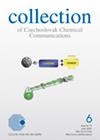A theoretical study of the nitration of eugenol with the nitronium ion
引用次数: 0
Abstract
The nitration of eugenol was investigated by using density functional theory (DFT) calculations. Potential energy surface and molecular electrostatic potential of eugenol was constructed in order to find, respectively, the minimum energy conformers and the possible sites for electrophilic attack. Stationary points were located and characterized at the B3LYP/6-311++G(2d,2p) level of theory. A strongly bound π-complex was found, in which the distance between the nitrogen atom of the NO2 moiety and the C1 carbon atom of the aromatic ring is 2.15 A in the gas phase and 2.06 A in dichloromethane. The most favorable σ-complex or Wheland intermediate is the result from the interaction between the nitrogen and the C6 ring carbon atom. The transition state that connects both complexes is more resembling the σ-complex. The nitronium ion exothermically reacts with eugenol to give the π-complex without an energy barrier. The next stage of the reaction pathway, π-complex → σ-complex, is endothermic and involves a Gibbs energy of activation of 7.9–8.0 kcal mol–1 (gas phase) and 8.3–8.9 kcal mol–1 (CH2Cl2).丁香酚氮离子硝化反应的理论研究
采用密度泛函理论(DFT)对丁香酚的硝化作用进行了研究。构造了丁香酚的势能面和分子静电势,分别寻找了能量最小的构象和亲电攻击的可能位点。在理论的B3LYP/6-311++G(2d,2p)水平上定位和表征了驻点。发现了一个强结合π配合物,其中NO2部分的氮原子与芳香环的C1碳原子之间的距离在气相中为2.15 A,在二氯甲烷中为2.06 A。最有利的σ-配合物或Wheland中间体是氮与C6环碳原子相互作用的结果。连接这两个配合物的过渡态更类似于σ-配合物。硝酸离子与丁香酚放热反应生成π-配合物,无能垒。下一反应阶段π-络合物→σ-络合物为吸热反应,吉布斯活化能为7.9 ~ 8.0 kcal mol-1(气相)和8.3 ~ 8.9 kcal mol-1 (CH2Cl2)。
本文章由计算机程序翻译,如有差异,请以英文原文为准。
求助全文
约1分钟内获得全文
求助全文

 求助内容:
求助内容: 应助结果提醒方式:
应助结果提醒方式:


